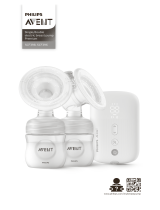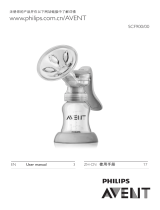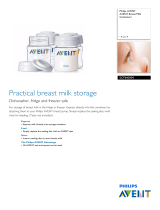
GB
6. (1)–(7)
IMPORTANT: DO NOT LOSE THE WHITE VALVE. YOUR PUMP
WILL NOT WORK WITHOUT IT OR IF IT IS FITTED INCORRECTLY.
If lost, spare valves are available direct from Philips AVENT.
ATTENTION : VOTRE TIRE-LAIT NE FONCTIONNERA PAS SANS
CETTE PIÈCE. SI ELLE EST MISE À L’ENVERS OU MAL PLACÉE,
IL N’Y AURA PAS D’ASPIRATION. (Des valves de rechange
sont disponibles.)
WICHTIG: VERLIEREN SIE DAS WEISSE VENTIL NICHT! OHNE DAS
VENTIL ODER MIT VERKEHRT HERUM EINGESETZTEM VENTIL
FUNKTIONIERT DIE MILCHPUMPE NICHT. Ersatzventile sind bei
Bedarf direkt bei Philips AVENT erhältlich.
Contents
1. Introducing the manual breast pump
2. Detailed parts guide
3. Cleaning and sterilisation
4. Keeping your breast pump sterile for travel
5. Using the manual breast pumpwith the
AVENT VIA storage system
6. How to assemble the manual breast pump
7. When to express milk
8. Hints to help you succeed
9. How to use the manual breast pump
10. Storing your breast milk
11. Feeding your baby your expressed breast milk
12. Choosing the right teat for your baby
13. Troubleshooting guide
Please take five minutes to read through the WHOLE
of this leaflet BEFORE you use your Philips AVENT
manual breast pump for the first time.
Should you ever lose these instructions, they are
available on our website: www.philips.com/AVENT
LET OP ! RAAK HET WITTE VENTIEL NIET KWIJT, ZONDER DIT VENTIEL
WERKT UW KOLF NIET. UW KOLF WERKT OOK NIET WANNEER
ONDERDELEN NIET CORRECT ZIJN GEPLAATST. Een reserve ventiel
kunt u aanvragen via de Philips AVENT consumentenlijn.
NL
13. Problemen & oplossingen
Controleer dat alle kolfonderdelen op de juiste manier in elkaar
zijn gezet en dat het witte ventiel met de ster naar boven wijst.
Zorg ervoor dat het siliconen massagekussentje en het membraan
goed op de kolf zijn aangebracht en dat deze goed aansluiten.
Controleer of er zuigkracht ontstaat en dat de kolf correct in
elkaar is gezet. Ontspan en probeer nogmaals, oefening baart
kunst! Lees de “Tips voor het succesvol afkolven”
nog eens door.
Het kan zijn dat u te hard kolft. U hoeft de hendel niet
in zijn geheel in te drukken om af te kolven.
Probeer de hendel maar tot halverwege in te drukken en
denk aan het kolfritme van 2 à 3 seconden.
Raadpleeg uw consultatiebureau of lactatiedeskundige.
Neem het massagekussentje van de trechter en plaats
opnieuw, zorg ervoor dat het massagekussentje goed aansluit
en dat het ver genoeg in de trechter is geplaatst. Neem de
“Gebruiksaanwijzing van de AVENT borstkolf” nog eens door.
Vermijd contact met antibacteriële reinigingsproducten,
deze kunnen het plastic beschadigen. De combinatie van
schoonmaakmiddelen, sterilisatie oplossingen, ontkalkt water
en temperatuurschommelingen kunnen in sommige gevallen
barsten in het plastic veroorzaken. In dit geval, niet gebruiken.
Neem voor het verkrijgen van losse onderdelen contact op
met de Philips AVENT consumentenlijn. De kolf is geschikt
voor de vaatwasser – kleurstoffen in voedingsresten kunnen
verkleuring van het plastic veroorzaken. Houd het product uit
rechtstreeks zonlicht. Langdurige blootstelling aan zonlicht kan
verkleuring veroorzaken.
Losse onderdelen zijn verkrijgbaar via de Philips AVENT
Consumentenlijn (zie achterkant voor contactinformatie)
Indien u alsnog problemen met uw kolf ondervindt, neem dan contact op met de
Philips AVENT consumentenservice via de genoemde telefoonnummers of raadpleeg
uw kraamverzorgster, consultatiebureau of lactatiekundige.
41
Geen zuigkracht
Uw melk vloeit niet
Pijn in de borst
tijdens het kolven
Melk vloeit terug
achter het siliconen
massagekussentje
Barstjes en verkleuren
van onderdelen
Verloren of kapotte
onderdelen

















